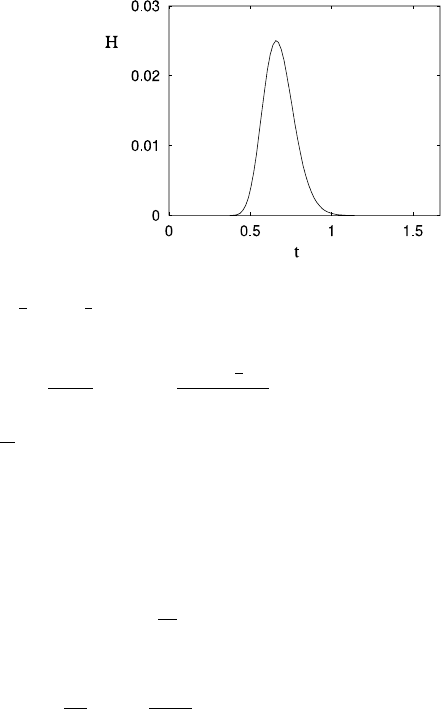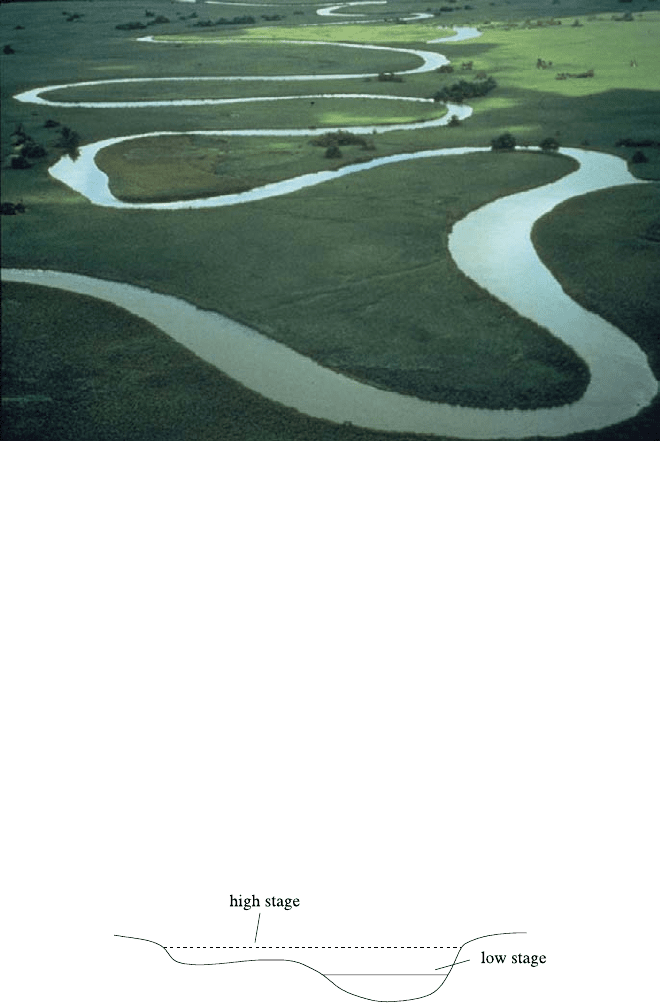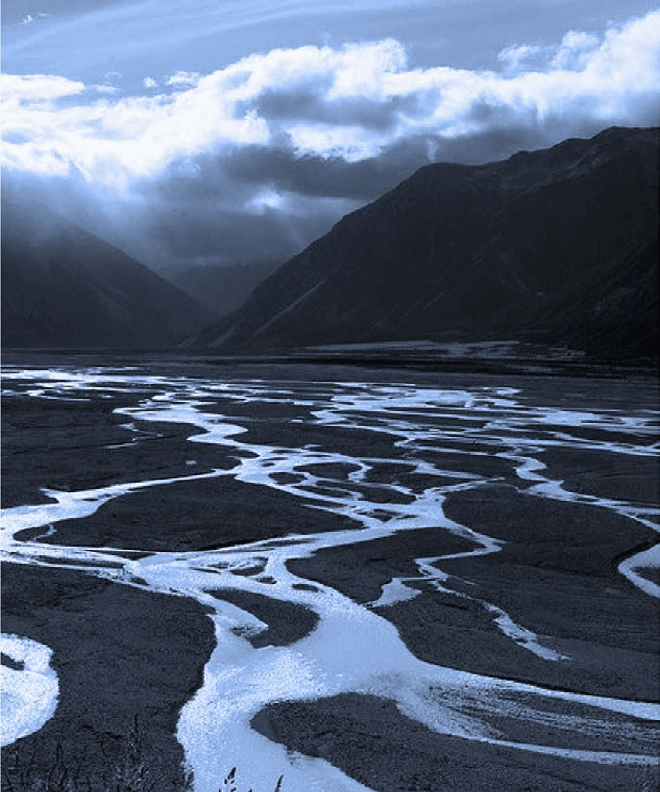Fowler A. Mathematical Geoscience
Подождите немного. Документ загружается.


260 4 River Flow
damped oscillator for ψ), so that the oscillations are damped towards the minimum
of W ; and the small term in n in (4.171) causes a drift upwards in φ towards the
outer solution given by φ
Z
≈
n(φ)
p(φ)
. Both these features can be seen in Fig. 4.21.
Although in this context, the introduction of the long wave dispersive term u
sss
in
(4.164) is merely suggestive, it does show that such a term can produce the undular
bore seen in practice at relatively low Froude number. The classical approach is
given in the paper by Peregrine (1966), who simply writes down as a model the
Benjamin–Bona–Mahony (BBM) equation, also called the regularised long wave
(RLW) equation, which in essence introduces a term u
sst
in (4.164) in place of u
sss
.
The BBM equation was (re-)introduced by Benjamin et al. (1972) as a suggested
improvement to the Korteweg–de Vries (KdV) equation, on the basis that it has
better regularity properties. Specifically, the dispersion relation for modes e
ik(s−ct)
is c =1 +k
2
for the linearised KdV equation u
t
+u
s
= u
sss
, while it is c =
1
1+k
2
for the linearised BBM equation u
t
+u
s
= u
sst
. The growth of the wave speed at
large wave number is associated with ill-posedness. See also Question 9.9.
4.7 Exercises
4.1 Find a relationship between the hydraulic radius R and the area A for trian-
gular (notch shaped) or rectangular (canal shaped) cross sections. Hence show
that Chézy’s and Manning’s laws both lead to a general relationship of the
form
Q =
cA
m+1
m +1
,
with 0 <m<1, giving explicit prescriptions for c and m. For a canal of depth
h, show that the flow is turbulent if
h 10
2
ν
2/3
f
Sg
1/3
,
where ν is the kinematic viscosity, f is the friction factor, S is the slope and g
is gravity. Taking ν =10
−6
m
2
s
−1
, f =0.01, S =10
−3
, g =10 m s
−2
, find a
critical depth for turbulence. Is the Thames turbulent?
4.2 For flow in a pipe, the friction factor f in the formula τ =fρu
2
is often taken
to depend on the Reynolds number; for example, Blasius’s law of friction has
f ∝ Re
−1/7
. By taking Re = UR/ν, where R is the hydraulic radius, find
modifications to Chézy’s law if f ∝ Re
−β
. Comment on whether you can
obtain Manning’s flow law this way.
4.3 The cross-sectional area of a river A is assumed to satisfy the wave equation
∂A
∂t
+cA
m
∂A
∂s
=0,
where s is distance downstream. Explain how this equation can be derived
from the principle of conservation of mass. What assumptions does your
derivation use?

4.7 Exercises 261
A river admits a steady discharge Q =Q
+
.Att =0, a tributary at s =0is
blocked, causing a sudden drop in discharge to Q
−
<Q
+
. Solve the equation
for A using a characteristic diagram and show that an expansion fan branches
from s = 0, t = 0. What is the hydrograph record at a downstream station
s =s
0
> 0?
Later, the tributary is re-opened, causing a sudden rise from Q
−
to Q
+
.
Draw the characteristic diagram, and show that a shock wave propagates for-
wards. What is its speed?
4.4 Use the method of characteristics to find the general solution of the equation
describing slowly varying flow of a river. Show also that in general shocks will
form, and describe in what situations they will not. What happens in the latter
case?
Either by consideration of an integral form of the conservation of mass
equation, or by consideration from first principles, derive a jump condition
which describes the shock speed. In terms of the local water speed, what is the
speed of a shock (a) when it first forms; (b) when it advances over a dry river
bed?
4.5 A river of rectangular cross section with width w carries a steady discharge Q
0
(m
3
s
−1
). At time t =0, a rainstorm causes a volume V of water to enter the
river at the upstream station s =0. Assuming Chézy’s law, find the solution for
the resulting flood profile (sketch the corresponding characteristic diagram),
and derive a (cubic) equation for the position of the advancing front of the
flood. Without solving this equation, find an expression for the discharge Q
l
at the downstream station s =l.
4.6 Derive the St. Venant equations from first principles, indicating what as-
sumptions you make concerning the channel cross section. Derive a non-
dimensional form of these equations assuming Manning’s roughness law and
a triangular cross section. [Assume that there is no source term in the equation
of mass conservation.]
A sluice gate is opened at s =0 so that the discharge there increases from
Q
−
to Q
+
. The hydrograph is measured at s = l.Usingl as a length scale,
and with a corresponding time scale ∼l/u, derive an approximate expression
for the dimensionless discharge in terms of A, if the Froude number is small,
and also ε =[
¯
h]/Sl 1, where [
¯
h] is the scale for the mean depth and S is
the slope.
Hence show that A satisfies the approximate equation
∂A
∂t
+
4
3
A
1/3
∂A
∂s
=
1
4
ε
∂
∂s
A
5/6
∂A
∂s
.
What do you think the difference between the hydrographs for ε =0 and 0 <
ε 1 might be?
4.7 Why should the equation
A
t
+cA
m
A
s
=M
represent a better model of slowly varying river flow than that with M =0?
Find the general solution of the equation, given that A = 0ats = 0, and

262 4 River Flow
A = A
0
(s) at t = 0, s>0, assuming M = M(s). Find also the steady state
solution A
eq
(s). How would you expect solutions representing disturbances to
this steady profile to behave?
Suppose now that M is constant, and A
0
= A
eq
+ Aδ(s), representing an
initial flood concentrated at s =0. Show that the resulting flood occurs in s
−
<
s<s
+
, and show that the profile of A between s
−
and s
+
is given implicitly
by
A
m+1
−(A −Mt)
m+1
=
(m +1)Ms
c
,
and deduce that
s
−
=
cM
m
t
m+1
(m +1)
.
What happens as M →0?
4.8 A dimensionless long wave model for slowly varying flow of a river of depth
h and mean velocity u is given in the form
h
t
+(uh)
s
=M(s),
0 =1 −
u
2
h
−εh
s
,
where ε 1.
How would you physically interpret the positive source term M(s)?
Show that for small ε, the model can be reduced to the approximate form
h
t
+
h
3/2
s
=M(s)+
1
2
ε
h
3/2
h
s
s
.
Show that if h = 0ats = 0, then an approximate steady state solution is
given by
h =
s
0
M(s)ds
2/3
. (∗)
Find this approximate solution if M ≡ 1. Can you find a function M for
which (∗) is the exact solution?
Explain why the condition of a horizontal water surface might be an ap-
propriate boundary condition to apply at s = 1, and show that in terms of the
scaled variables, this implies h
s
= 1/ε at s = 1. Show that with this added
boundary condition, the approximate solution (when M ≡1) is still appropri-
ate, except in a boundary layer near the outlet.
Next, suppose that M = 0 for large enough s, and that
∞
0
M(s)ds = 1.
Write down the linear equation satisfied by small perturbations H to the steady
state h =1 when s is large.
By seeking solutions of the form exp[σt +iks], show that small wave-like
disturbances travel at speed
3
2
and decay on a time scale t ∼O(1/ε).

4.7 Exercises 263
Fig. 4.22 H(s,t)plotted at
fixed s =1 as a function of t ,
using values ε =0.03,
l =0.005, δ =1
Show that if ζ = s −
3
2
t, τ =
1
2
εt, then H
τ
=H
ζζ
, and deduce that if H =
δ exp[−s
2
/l
2
] at t =0, then
H =δ
t
0
t
0
+t
1/2
exp
−
s −
3
2
t
2
2ε(t
0
+t)
for t>0, where t
0
=
l
2
2ε
. (A typical hydrograph described by this function is
shown in Fig. 4.22. It is asymmetric, but the steep shock-like rise is limited by
the linearity of the model.)
4.9 A dimensionless model for the steady, tranquil flow of a river of depth h, width
w and mean velocity u is given in the form
(wuh)
s
=M,
F
2
uu
s
=1 −
u
2
h
−h
s
.
If F =0, deduce that h satisfies the first-order ordinary differential equation
dh
ds
=1 −
Q
2
w
2
h
3
,
where
Q =
s
0
M(s)ds.
Show that if w =1 and M =1, there is no solution of this equation satisfying
h(0) =0.
Consider variously and in combinations the cases that w = s
1/2
, M =
(1 + w
2
)
1/2
, M = w (motivating these choices physically), and show that
a solution with h(0) =0 still cannot be found. Show that this remains true if
F>0. What do you conclude?
4.10 A dimensionless model for the steady, tranquil flow of a river of depth h and
mean velocity u is given in the form
uh = s,
F
2
su
s
=h −u
2
−hh
s
+δ(hu
s
)
s
,

264 4 River Flow
where δ 1, and we require h ∼s
2/3
as s →∞, and h(0) =0.
Suppose that F =0. Show that the leading-order outer solution (with δ =0)
satisfies the far field boundary condition for a unique choice of lim
s→0
h =h
0
.
By writing s =e
δX
, show that a boundary layer exists in which h changes from
zero to h
0
. Show also that h ∼s
h
2
0
/2δ
as s →0.
What happens if F =0?
4.11 Using Chézy’s law with a rectangular cross section, show how to non-
dimensionalise the St. Venant equations, and show how the model depends on
the Froude number, which you should define. Choose or guess suitable values
for the Thames in London, the Isis/Cherwell in Oxford, the Quoile in Down-
patrick, the Liffey in Dublin, the Charles in Boston, the Shannon in Limerick,
the Lagan in Belfast (or your own favourite stretch of river), an Alpine (or
other) mountain stream, and determine the corresponding natural length and
time scales, and the Froude number, for these flows. Show also that in the case
of long wave and short wave motions, the equations effectively become those
of slowly varying flow and the shallow water equations, respectively.
4.12 The St. Venant equations, assuming Manning’s roughness law, zero mass in-
put, and a triangular river cross section, can be written in the dimensionless
form
A
t
+(Au)
s
=0,
F
2
(u
t
+uu
s
) =1 −
u
2
A
2/3
−
A
s
2A
1/2
.
Show in detail that small disturbances to the steady state A =u =1 can prop-
agate up and down stream if F<F
1
, but can only propagate downstream if
F>F
1
, and that they are unstable if F>F
2
. What are the values of F
1
and
F
2
?
4.13 A river flows through a lowland valley. The river level may fluctuate, so that it
lies above or below the local groundwater level. Give a simple motivation for
the model
∂A
∂t
+cA
m
∂A
∂s
=−r(A −B),
∂B
∂t
=r(A−B)
to describe the variations of river water (A) and groundwater (B), where B is
a measure of the amount of groundwater.
Show that small disturbances to the uniform state A =B =1 exist propor-
tional to exp[σt +iks] and find the dispersion relation relating σ to k. What
do these solutions represent?

4.7 Exercises 265
4.14 The hydraulic jump
Using the dimensionless form of the mass and momentum equations (for
a canal), show that discontinuities (shocks) in the channel depth travel at a
(dimensionless) speed V given by
V =
[Au]
+
−
[A]
+
−
=
[F
2
Au
2
+
1
2
A
2
]
+
−
[F
2
Au]
+
−
,
where ± refer to the values on either side of the jump, and F is the Froude
number. Show that a stationary jump at s = 0 is possible (this can be seen
when a tap is run into a flat basin) if Au =Q in s>0 and s<0, and
F
2
Q
2
A
+
A
2
2
+
−
=0.
Deduce that for prescribed Q and A
−
, a unique choice of A
+
=A
−
is possi-
ble. Show also that the locally defined Froude number is
Fr =
FQ
A
3/2
,
and deduce that the hydraulic jump connects a region of supercritical (Fr > 1)
flow to a subcritical (Fr < 1) one. (In practice, A
−
<A
+
if Q>0; if A
−
>
A
+
, the discontinuity cannot be maintained.)
4.15 The functions N(φ
+
,φ
−
) and D(φ
+
,φ
−
) are defined by
N(φ
+
) =
φ
−
φ
+
(φ
2
+φ +1){φ +γ(φ−1)}dφ
(φ −γ)
2
−γ
2
φ
,
D(φ
+
) =
φ
−
φ
+
(φ
2
+φ +1)dφ
(φ −γ)
2
−γ
2
φ
,
where φ
−
>φ
+
, and the quantities L and c are defined by
L =
γ
2
D
5/3
N
2/3
,c=
(1 +γ)D
1/3
N
1/3
,
where γ is constant.
Evaluate the integrals to find explicit expressions for N and D, and show
that as φ
+
→α
+
,
D =−A ln(φ
+
−α
+
) +D
0
+o(1), N =−C ln(φ
+
−α
+
) +N
0
+o(1),
and find explicit expressions for A, C, D
0
and N
0
. Hence show that as
φ
+
→α
+
,
ln
1
φ
+
−α
+
≈b(L +L
∗
) +O
1
(L +L
∗
)
,
where the constant b should be determined, and deduce that
c ≈c
+
−
k
L +L
∗
+O
1
(L +L
∗
)
2
,
266 4 River Flow
where k and L
∗
should be found. By evaluating k and L
∗
for different values
of γ , show that both quantities increase rapidly as γ is reduced, and hence
explain why the convergence of c to c
+
in Fig. 4.13 is so slow. Compare this
asymptotic result with a direct numerical evaluation of c(L). How good is the
asymptotic result?
Chapter 5
Dunes
The muddy colour of many rivers and the milky colour of glacial melt streams are
due to the presence in the water of suspended sediments such as clay and silt. The
ability of rivers to transport sediments in this way, and also (for larger particles)
by rolling or saltation as bedload transport, forms an important constituent of the
processes by which the Earth’s topography is formed and evolved: the science of
geomorphology.
Sediment transport occurs in a variety of different (and violent) natural scenarios.
Powder flow avalanches, sandstorms, lahars and pyroclastic flows are all examples
of violent sediment laden flows, and the kilometres long black sandur beaches of
Iceland, laid down by deposition of ash-bearing floods issuing from the front of
glaciers, are testimony to the ability of fluid flows to transport colossal quantities
of sediment. In this chapter we will consider some of the landforms which are built
through the interaction of a fluid flow with an erodible substrate; in particular we
will focus on the formation of dunes and anti-dunes in rivers, and aeolian dunes in
deserts.
5.1 Patterns in Rivers
There are two principal types of patterns which are seen in rivers. The first is a
pattern of channel form, i.e., the shape taken by the channel as it winds through the
landscape. This pattern is known as a meander, and an example is shown in Fig. 5.1.
The second type of pattern consists of variations in channel profile, and there
are a number of variants which are observed. A distinction arises between profile
variations transverse to the stream flow and those which are in the direction of flow.
In the former category are bars; in the latter, dunes and anti-dunes. The formation of
lateral bars results in a number of different types of river, in particular the braided
and anastomosing river systems (described below).
All of these patterns are formed through an erosional instability of the uniform
state when water of uniform depth and width flows down a straight channel. The
instability mechanism is simply that the erosive power of the flowing water increases
A. Fowler, Mathematical Geoscience, Interdisciplinary Applied Mathematics 36,
DOI 10.1007/978-0-85729-721-1_5, © Springer-Verlag London Limited 2011
267

268 5 Dunes
Fig. 5.1 A meandering river, the Okavango in Botswana. Photograph supplied by courtesy of Gary
Parker, and reprinted with permission of Terence McCarthy
with water speed, which itself increases with water depth. Thus a locally deeper
flow will scour its bed more rapidly, forming a positive feedback which generates
the instability. The different patterns referred to above are associated with different
geometric ways in which this instability is manifested.
River meandering occurs when the instability acts on the banks. A small oscilla-
tory perturbation to the straightness of a river causes a small secondary flow to occur
transverse to the stream flow, purely for geometric reasons. This secondary flow is
directed outwards (away from the centre of curvature) at the surface and inwards
at the bed. As a consequence of this, and also because the stream flow is faster on
the outside of a bend, there is increased erosion there, and this causes the bank to
migrate away from the centre of curvature, thus causing a meander.
Braided rivers form because of a lateral instability which forms perturbations
called bars. This is indicated schematically in Fig. 5.2. A deeper flow at one side
Fig. 5.2 Cross section of a braided river with one lateral bar, which is exposed when the river is at
low stage (i.e., the river level is low). The instability which causes the bar is operative in stormflow
conditions, when the bar is submerged

5.1 Patterns in Rivers 269
Fig. 5.3 A braided river. Image from http://www.braidedriver.net
of a river will cause excess erosion of the bed there, and promote the development
of a lateral bar in stormflow conditions. The counteracting (and thus stabilising)
tendency is for sediments to migrate down the lateral slope thus generated. Bars
commonly form in gravel bed rivers, and usually interact with the meandering ten-
dency to form alternate bars, which form on alternate sides of the channel as the
flow progresses downstream. In wider channels, more than one bar may form across
the channel, and the resulting patterns are called multiple row bars. In this case the
stream at low stage is split up into many winding and connected braids, and the river
is referred to as a braided river, as shown in Fig. 5.3.
